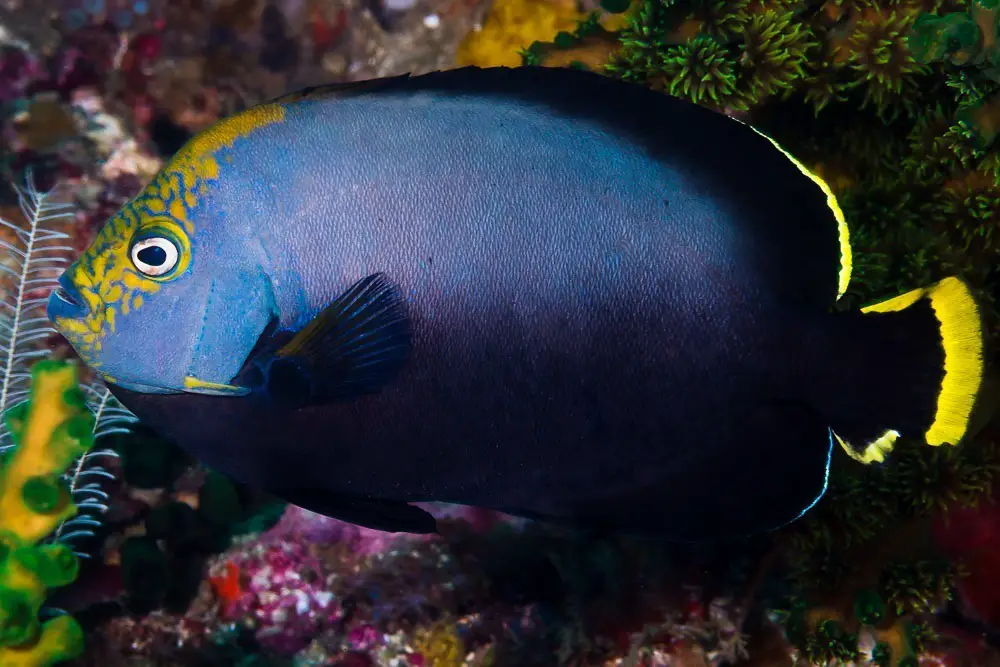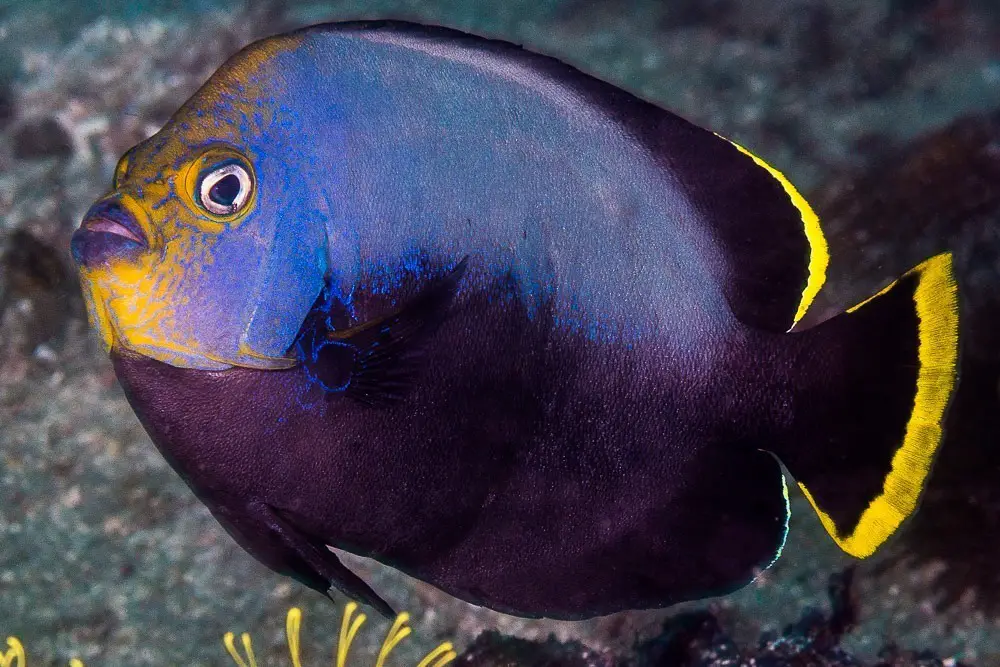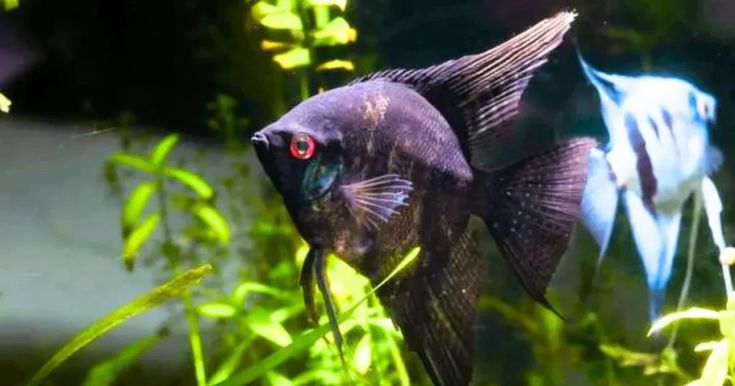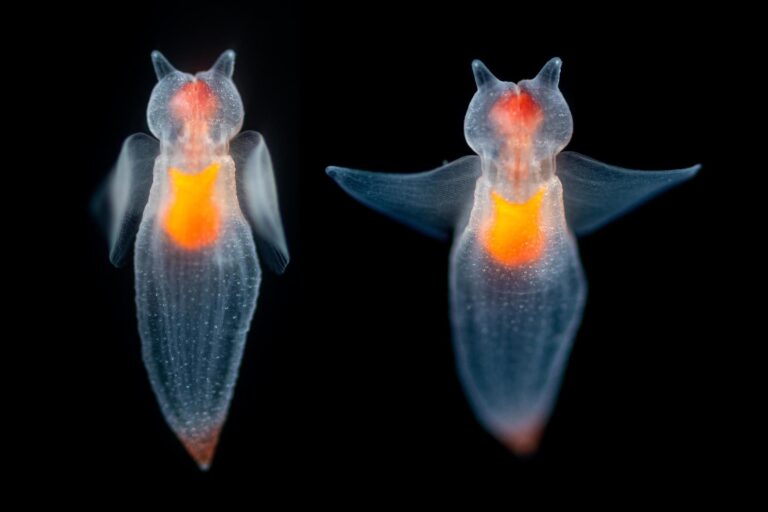The Exquisite Elegance of Black Angelfish in Your Aquarium
The captivating charm of the black angelfish isn’t just in its name—this species boasts an alluring sophistication and mystique that has made it a sought-after addition to many home aquariums. From its striking coloration to its elegant demeanor, the black angelfish stands as a testament to the beauty of the underwater world. In this comprehensive exploration, we will discover everything you need to know about keeping black angelfish, from setting up their perfect habitat to understanding their unique behaviors and needs.

Understanding the Black Angelfish
The black angelfish (Pterophyllum scalare) is a species native to the freshwater streams of the Amazon River and its tributaries, particularly in the South American countries of Peru, Brazil, and Colombia. Known for their deep, velvety black bodies and long, flowing fins, they are a favorite among aquarium enthusiasts looking to add a touch of elegance to their tanks.
A Fish of Grace and Beauty
The black angelfish is much more than just a pretty face. With a height of up to 6 inches and a length of 7 inches, these streamlined creatures have a powerful vertical presence in any aquarium. They are a hardy species, able to tolerate a wide range of conditions, and famed for their peaceful demeanor, making them an excellent choice for community tanks.
The Nurturer and Protector
Black angelfish exhibit fascinating parental behaviors. They are known to care for their young with dedication, protecting their fry fiercely until they are large enough to fend for themselves. This nurturing instinct further endears them to aquarists seeking to witness the full cycle of life in their tanks.
The Aquarium Aesthete’s Favorite
Aquarium aficionados are drawn to black angelfish for more than just their good looks. The dark coloration of black angelfish provides a striking contrast to the typically vibrant hues of most tropical aquarium fish. Their long, vertical bodies also add a dynamic element to aquascapes, gracefully gliding through plants and rock formations.
An Exercise in Contrast
When paired with bright or lighter-colored species, the contrast created with black angelfish is aesthetically pleasing and can significantly enhance the visual appeal of your tank. Bold aquascapers can even use lighting and shadow effects to accentuate the angelfish’s features, turning them into living works of art.
Peaceful Beauty
Despite their formal appearance, black angelfish are not aggressive fish. They generally coexist peacefully with other tank inhabitants, as long as they have sufficient space and are not overcrowded. Their placid nature makes them an ideal community tank resident, harmoniously swimming alongside other non-aggressive species.
Creating the Perfect Angelfish Habitat
Setting up the ideal environment for black angelfish is crucial for their health and happiness. Providing a suitable tank with the right conditions will allow these majestic creatures to thrive.
Tank Setup and Decor
Black angelfish are accustomed to waters with minimal flow in their natural environment. Therefore, their tank should have slow filtration and soft lighting to simulate their native Amazonian habitat. Decorate the tank with live plants, driftwood, and smooth rocks to provide hiding spots and break lines of sight within the tank.
Water Conditions
Maintaining the proper water parameters is vital. The ideal temperature for black angelfish is between 76-82 degrees Fahrenheit, with a pH level of 6.5-7.5. Regular water changes, a well-established biological filter, and the use of a dechlorinator are essential for keeping conditions pristine.
The Importance of Space
Black angelfish are relatively large and require plenty of room to swim. A minimum tank size of 30 gallons is recommended for a pair, with an additional 10 gallons for each additional angelfish. Overcrowding can lead to stress and territorial behavior, so be sure to calculate the space requirements carefully.
Feeding Your Angelfish
A balanced diet is key to the health of your black angelfish. They are omnivorous and will eat both animal-based and plant-based foods.

The Omnivorous Palate
In the wild, black angelfish feed on small crustaceans, worms, and plant matter. In captivity, they should be given a variety of foods, including high-quality flakes, pellets, live or frozen brine shrimp, bloodworms, and a range of vegetables such as spinach and zucchini, which provide essential nutrients and fiber.
Feeding Frequency
Feed your black angelfish 2-3 times a day, only providing what they can consume in 2-3 minutes per feeding. Overfeeding can lead to health issues and compromise water quality, so portion control is crucial.
Breeding Angelfish
Witnessing the breeding behavior of black angelfish can be one of the most exciting experiences for an aquarium hobbyist. When conditions are right, these devoted parents will spawn and care for their young.
Preparing for Breeding
Black angelfish are most likely to spawn in pairs. To encourage breeding, provide ample space, a varied diet, and pristine water conditions with regular, large water changes. Slightly lowering the water level can also simulate their natural environment’s rainy season, which can trigger spawning behavior.
Spawning Rituals
The male and female will typically begin a courtship ritual, often alongside a plant leaf or other flat surface that will serve as the spawning site. The female will lay her eggs, and the male will fertilize them externally. They will then take turns guarding the eggs and fanning them with their fins to ensure proper water flow.
Raising the Fry
After a few days, the eggs will hatch, and the fry will be free-swimming. At this point, the parents may move them to a different location. If not, it might be necessary to remove the fry from the main tank to prevent them from being eaten by tank mates.
Your Black Angelfish and Their Tank Mates
Selecting suitable tank mates for your black angelfish is critical to maintaining a peaceful and stress-free community aquarium. Avoid pairing them with nippy or aggressive fish that could harass the angelfish.
Choosing Compatible Species
Tetras, peaceful cichlids, catfish, and other similar-sized fish make good companions for black angelfish. Be mindful of the overall size of the tank and ensure the other species have compatible environmental conditions and diet requirements.
Ensuring a Harmonious Community: Black Angelfish
It’s essential to observe the interactions between tank mates, especially in the early stages of introducing new fish. Some territorial posturing may occur as the pecking order is established, but this should subside as the community settles in.
Identifying and Dealing with Health Issues
Like all aquarium fish, black angelfish are susceptible to various health problems. Understanding the signs of illness and taking prompt action can improve the chances of recovery.
Common Health Ailments
Health issues in black angelfish can include bacterial, parasitic, or fungal infections, as well as digestive problems from poor diet or water quality. Symptoms may include changes in behavior, appetite, or coloration, as well as visible signs such as lesions or spots on the body.
Prevention and Treatment
Maintaining good water quality, providing a balanced diet, and regular observation of your fish can help prevent many health issues. Quarantining new additions to the tank can also prevent the spread of disease. If you do notice signs of illness, consult with a knowledgeable aquarium professional to determine the best course of treatment.

Varieties of Black Angelfish
The classic black angelfish comes in variations that appeal to different tastes and add diversity to the species.
Veil-Tail and Other Morphs
Veil-tail black angelfish have extended, flowing fins that add an extra level of grace and movement to their already striking profile. Other morphs can include unique patterns and color variations that result from selective breeding and can create distinct looks within the black angelfish population.
Breeding for Beauty
Selective breeding has resulted in combinations of colors, patterns, and fin shapes that range from subtly different to dramatically unique. These varieties have a dedicated following within the aquarium community and are highly prized for their aesthetics.
In Conclusion: The Black Angelfish, an Underwater Gem
The black angelfish is not only an exquisite fish to behold but a joy to have in your aquarium. By providing the right conditions, diet, and care, you can enjoy their beauty and experience the wonders of their natural behaviors, including parenting and breeding. Always strive to learn more about black angelfish and their needs, and share your passion for these remarkable creatures with others in the aquarium community. Whether you are a seasoned hobbyist or just starting, the black angelfish can be the jewel of your aquatic world.







